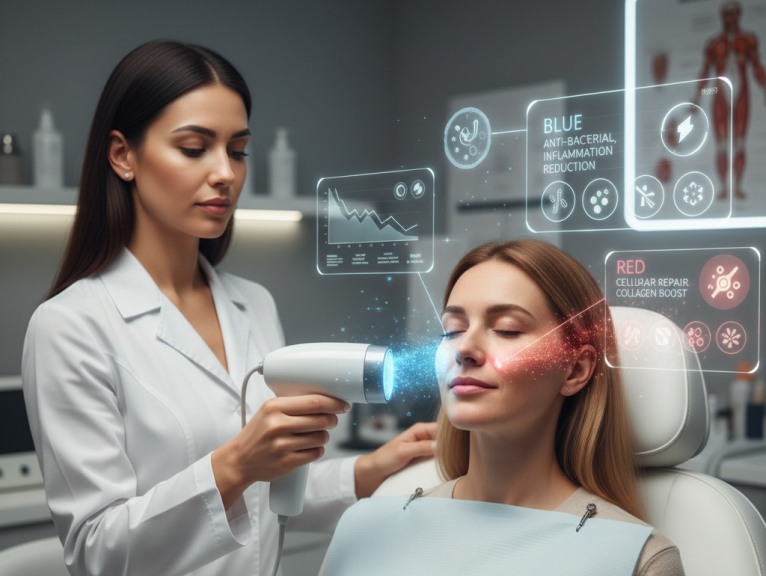
20 Years of Producing the Highest Quality, Most Reliable, and Effective LED mask.
Explore how blue and red light therapy can effectively treat rosacea. Learn about the mechanisms, clinical evidence, and practical applications for this promising treatment option.

Rosacea is a chronic skin condition that affects millions of people worldwide. It is characterized by facial redness, visible blood vessels, and in some cases, acne-like breakouts. It typically appears in individuals with fair skin and most commonly affects adults aged 30-50 years.
While the exact cause of rosacea remains uncertain, several factors have been identified as triggers, including genetics, immune system dysfunction, and environmental influences such as sunlight or hot weather. Traditional treatments for rosacea include topical medications, oral antibiotics, and laser therapy. However, many patients do not respond well to these treatments, or they may experience side effects. As a result, light therapy, particularly blue and red light therapy, has become a popular alternative treatment for rosacea.
Light therapy offers a non-invasive, drug-free way to manage rosacea symptoms, reduce inflammation, and enhance skin healing. In this article, we will explore how blue and red light therapies work, clinical evidence supporting their use, and practical recommendations for incorporating them into your rosacea treatment routine.
Blue light therapy involves the use of light with wavelengths between 400 and 470 nanometers. It is most commonly known for its antimicrobial effects, particularly against Propionibacterium acnes (P. acnes), a bacterium often associated with acne outbreaks. For rosacea, blue light therapy helps reduce bacteria on the skin, which can decrease inflammation and lessen symptoms like pimples and pustules.
Red light therapy operates within the wavelength range of 600-650 nanometers. It penetrates deeper into the skin than blue light and is used to stimulate cellular processes such as collagen production. Red light therapy is effective for treating the vascular component of rosacea, which includes facial redness and visible blood vessels.
Red light also promotes healing and skin repair, making it beneficial for those with skin damage caused by chronic inflammation.
Blue light therapy primarily works by targeting inflammation and bacterial overgrowth in rosacea. The key benefits include:
Red light therapy offers several benefits for rosacea patients, especially those dealing with facial redness and visible blood vessels. Key benefits include:
Both therapies target different aspects of rosacea, making their combined use particularly effective.
Several studies support the effectiveness of blue light therapy in treating rosacea. For example, a study published in the Journal of Clinical and Aesthetic Dermatology reported that blue light therapy significantly reduced rosacea-related papules and pustules in a 6-week clinical trial. The study also noted improvements in overall skin appearance and reduced irritation (PubMed).
Moreover, a systematic review published in Dermatologic Surgery found that blue light therapy could reduce the inflammatory lesions of rosacea with minimal side effects (pubmed.ncbi.nlm.nih.gov).
Red light therapy has also been extensively studied for its benefits in treating rosacea. In one study, patients who underwent red light therapy experienced a significant reduction in erythema and telangiectasia (visible blood vessels) after 10 treatments. This led to an overall improvement in skin appearance and texture (PubMed Central).
Another clinical trial published in Lasers in Surgery and Medicine confirmed that red light therapy reduced facial redness and improved the skin's overall health by stimulating collagen production (PubMed).
Studies have suggested that combining blue and red light therapy can provide enhanced results for rosacea patients. A clinical trial published in The Journal of Dermatological Treatment found that combining both therapies reduced inflammation, minimized redness, and improved skin texture in patients with rosacea. This combination treatment provides a comprehensive approach by addressing both the inflammatory and vascular components of the condition (PMC).
For optimal results, it’s recommended to undergo light therapy sessions 2–3 times a week, with each session lasting between 15 and 20 minutes. Treatment duration typically spans 4–6 weeks, depending on individual needs.
Several devices are available for home treatment, such as handheld units, LED face masks, and larger LED panels. When selecting a device, ensure that it emits the correct wavelengths—blue light (400–470 nm) for acne and red light (600–650 nm) for inflammation and collagen stimulation. Ensure that the device is FDA-cleared to guarantee its safety and effectiveness.
To address both bacterial inflammation and visible blood vessels, many patients benefit from combining blue and red light therapy in a single session. This approach can help reduce the redness, pimples, and pustules associated with rosacea, offering a well-rounded treatment plan.
Light therapy is generally considered safe for most individuals, including those with sensitive skin. However, precautions should be taken:
While side effects are rare, some individuals may experience mild irritation or dryness after light therapy. It's essential to follow the device’s instructions and start with shorter treatment sessions to assess your skin’s response.
A1: Light therapy cannot cure rosacea but can significantly improve its symptoms, such as redness, inflammation, and pustules. It helps control flare-ups and maintain long-term skin health.
A2: Most patients begin to see improvements within 2–4 weeks of consistent treatment. Visible reduction in redness and blemishes often takes longer, around 6–8 weeks.
A3: Yes, using FDA-cleared devices at home is generally safe. Always follow the device’s instructions carefully, and consult your dermatologist if you have concerns.
Blue and red light therapy offer effective, non-invasive treatments for managing rosacea symptoms. These therapies are well-supported by clinical evidence and provide a promising option for those looking for relief from the chronic condition. As technology continues to evolve, we can expect further improvements in the effectiveness and accessibility of light therapy for rosacea patients.
References:
